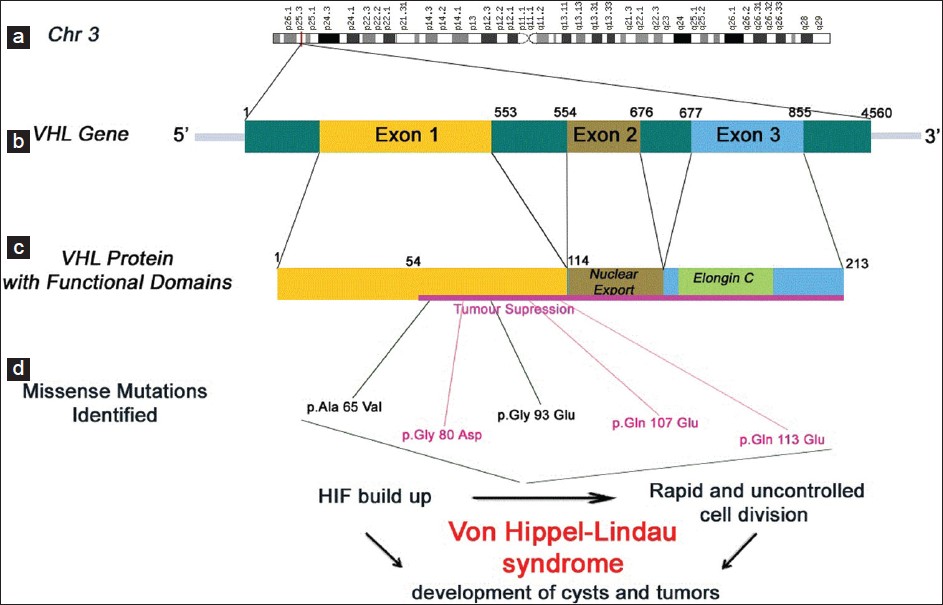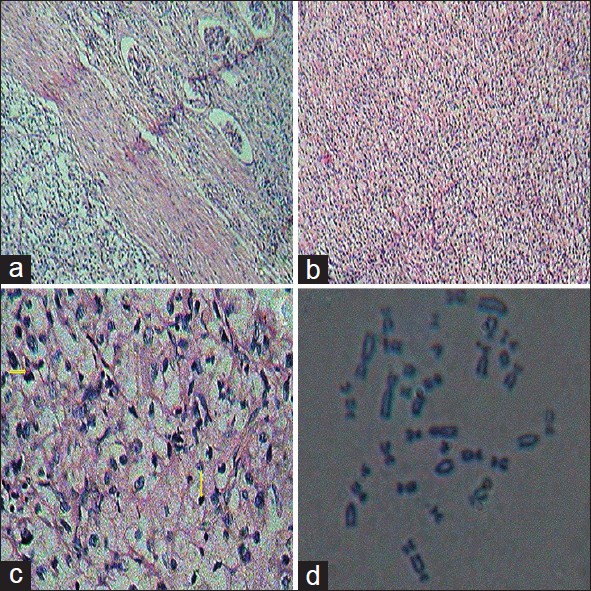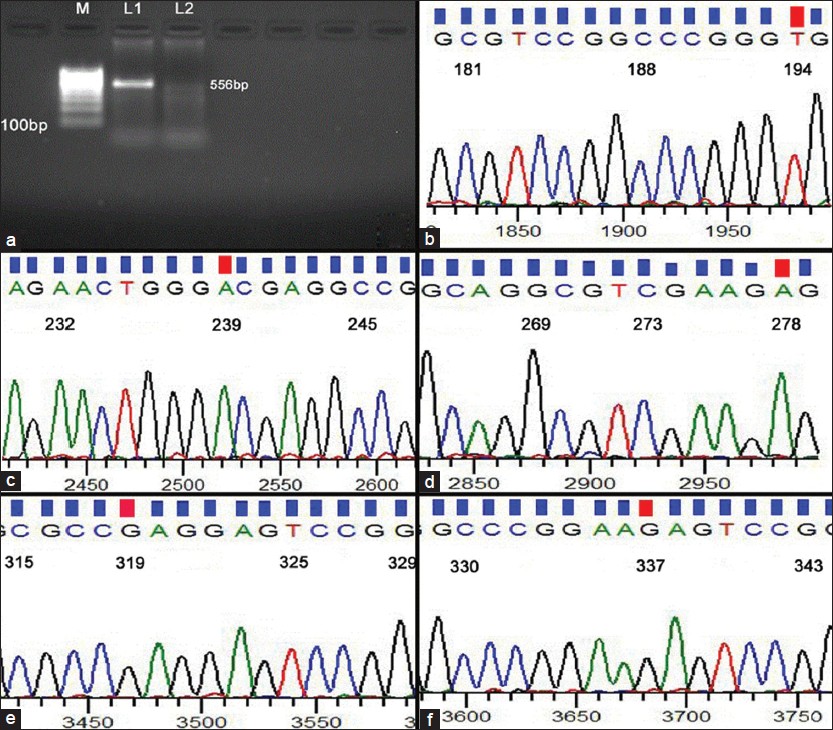|
 
 |
|
CASE REPORT |
|
|
|
| Year : 2013 | Volume
: 19
| Issue : 3 | Page : 373-376 |
| |
Novel three missense mutations observed in Von Hippel-Lindau gene in a patient reported with renal cell carcinoma
Pasupuleti Santhosh Kumar1, Katari Venkatesh1, Lokanathan Srikanth1, Potukuchi Venkata Gurunadha Krishna Sarma1, Akkamgari Ramprasad Reddy2, Srinivasan Subramanian2, Bobbidi Venkata Phaneendra3
1 Department of Biotechnology, Sri Venkateswara Institute of Medical Sciences, Tirupati, Andhra Pradesh, India
2 Department of Urology, Sri Venkateswara Institute of Medical Sciences, Tirupati, Andhra Pradesh, India
3 Department of Pathology, Sri Venkateswara Institute of Medical Sciences, Tirupati, Andhra Pradesh, India
| Date of Web Publication | 30-Oct-2013 |
Correspondence Address:
Potukuchi Venkata Gurunadha Krishna Sarma
Department of Biotechnology, Sri Venkateswara Institute of Medical Sciences, Tirupati - 517 507, Andhra Pradesh
India
 Source of Support: None, Conflict of Interest: None  | 2 |
DOI: 10.4103/0971-6866.120809

 Abstract Abstract | | |
Von Hippel-Lindau (VHL) disease is an autosomal dominant hereditary cancer syndrome that predisposes to the development of a variety of benign and malignant tumors, especially cerebellar hemangioblastomas, retinal angiomas and clear-cell renal cell carcinomas (RCC). We have identified of VHL gene using immunohistochemistry in a patient who was diagnosed for RCC. In order to understand the involvement of mutation in the VHL gene exon 1 was amplified and sequenced (accession number: JX 401534). The sequence analysis revealed the presence of novel missense mutations c.194 C>T, c.239 G>A, c.278 G>A, c.319 C>G, c. 337 C > G leading to the following variations p.Ala 65 Val, p.Gly 80 Asp, p.Gly 93 Glu, p.Gln 107 Glu, p.Gln 113 Glu in the protein.
Keywords: Missense mutation, renal cell carcinomas, Von Hippel-Lindau disease
How to cite this article:
Kumar PS, Venkatesh K, Srikanth L, Sarma PG, Reddy AR, Subramanian S, Phaneendra BV. Novel three missense mutations observed in Von Hippel-Lindau gene in a patient reported with renal cell carcinoma. Indian J Hum Genet 2013;19:373-6 |
How to cite this URL:
Kumar PS, Venkatesh K, Srikanth L, Sarma PG, Reddy AR, Subramanian S, Phaneendra BV. Novel three missense mutations observed in Von Hippel-Lindau gene in a patient reported with renal cell carcinoma. Indian J Hum Genet [serial online] 2013 [cited 2016 May 24];19:373-6. Available from: http://www.ijhg.com/text.asp?2013/19/3/373/120809 |
 Introduction Introduction | |  |
Renal cell carcinoma (RCC) is the most common malignancy of human kidney and accounts for approximately 2% of adult malignancies. It is estimated that the world-wide incidence of RCC. The Von Hippel-Lindau (VHL) gene alterations are responsible for a rare hereditary cancer syndrome, including inherited RCC. The VHL gene and its importance in regulation of the hypoxia pathway through the hypoxia inducible factors (HIFs), the VHL disease is an uncommon autosomal dominant disorder with high penetrance, which predisposes to a variety of neoplastic and non-neoplastic lesions affecting the multiple organs. The disease is caused by mutation of the VHL tumor suppressor gene (VHL gene) on the short arm of chromosome 3 (3p25-26) the gene spans 10 kb, is composed of three exons [Figure 1] and encodes two proteins (pVHL19 and pVHL30). The complete VHL protein consists of 214 amino acids and has two structural domains: The α-domain and the β-domain. [1] | Figure 1: Von Hippel-Lindau (VHL) gene and protein structure. (a) The VHL gene on the short arm of the 3rd chromosome (3p26-p25), the VHL gene is located from base pair 10,183,318 to base pair 10,195,353 on chromosome 3. (b) The VHL gene comprises three exons. Nucleotide number is indicated above the gene structure. (c) The VHL protein structure with Functional domains. Codon number is indicated above the protein structure. (d) The five residues subjected for missense mutations are p.Ala 65 Val, p.Gly 80 Asp, p.Gly 93 Glu, p.Gln 107 Glu, p.Gln 113 Glu
Click here to view |
Regulation of the expression of HIF-alpha (HIF-α) by the pVHL/E3 ubiquitin ligase complex is critical for the normal functioning of a cell. HIF is a heterodimeric transcription factor that mediates the cell's response to hypoxia. HIF is composed of a α-subunit (HIF-α), which is oxygen-sensitive and a β-subunit (HIF-1 β), which is constitutively expressed. In normoxia, key proline residues within HIF-α are prolyl hydroxylated. This enables recognition of HIF-α by the pVHL/E3 ubiquitin ligase complex and leads to polyubiquitination and degradation of HIF-α. In hypoxia due to the lack of available oxygen, hydroxylation of the proline residues does not occur and pVHL does not recognize HIF-α. The HIF-α protein then translocates to the nucleus where it dimerizes with HIF-1 β and activates the transcription of target genes. [2],[3] However, if loss of functional pVHL occurs due to the genetic or epigenetic events in normoxia, HIF-α is not targeted for degradation and consequently is constitutively up-regulated. This is a frequent occurrence in RCC. [4] The basic biology underlying the development of clear cell renal cell carcinoma is critically dependent on the VHL gene, whose protein product is important in the cell's normal response to hypoxia. Aberrations in VHL's function, either through mutation or promoter hypermethylation, lead to accumulation of the transcriptional regulatory molecule, HIF-α. [5],[6] In view of the importance of VHL gene in such conditions the present study is aimed to characterize VHL in an Indian patient reported in Sri Venkateswara Institute of Medical Sciences (SVIMS), Tirupati in the Department of Urology, with clear cell renal carcinoma as identified in the Department of Pathology.
 Case Report Case Report | |  |
Sample was collected from patient of the Department of Urology; SVIMS University diagnosed RCC by using immunohistochemistry [Figure 2]a-c in the Department of Pathology. Genetic analysis was carried out in the Department of Biotechnology. The patient granulocytes were isolated using Ficoll gradient method. The aberrations in the chromosomes were assessed by karyotyping [Figure 2]d. The exon 1 of VHL gene was amplified from the genomic deoxyribonucleic acid using the primers F: 5'- CCT CGC CTC CGT TAC-3' and R: 5'- TAC CTC GGT AGC TGT GGAT-3' which were designed from VHL gene of exon 1 reported in the genome database [Figure 3]a. Before sequencing single strand conformation polymorphism analysis showed distinct variations in the mobility of the patient polymerase chain reaction (PCR) product compared with normal. Therefore, the PCR amplified products were purified with nested primers-PCR Purification kit, Taurus Scientific, USA and were sequenced (Accession number: JX401534) by dye terminating method at MWG Biotech India Ltd. Thus, obtained VHL gene of exon 1 sequence was deposited at Gen Bank. | Figure 2: Immunohistochemistry of clear cell renal carcinoma. (a) Low power (×10) view of clear cell renal carcinoma with few glomeruli adjacent to the lesion. (b) Low power (×10) view of clear cell renal carcinoma. (c) High power (×40) of clear cell renal carcinoma comprised of round oval to polygonal cells with mildly pleomorphic vesicular nuclei, inconspicuous nucleoli and clear cytoplasm. Increased mitosis (shown in yellow arrow) was observed. (d) Karyotyping analysis of Von Hippel-Lindau gene mutation with clear cell renal carcinoma
Click here to view |
 | Figure 3: (a) Polymerase chain reaction (PCR) amplification of exon 1 of Von Hippel-Lindau (VHL) gene using VHL Forward primer (FP) and VHL Reverse primer (RP) primers following the method described, Lane M molecular size marker obtained from Bangalore Genei Pvt. Ltd., lane L1 PCR amplified product. (b-d) The chromatogram showing mutations in p.Ala 65 Val, p.Gly 80 Asp, p.Gly 93 Glu, p.Gln 107 Glu, p.Gln 113 Glu in exon 1 of VHL gene leading to missense mutations
Click here to view |
The sequence was basic local alignment search tool searched against the human genome sequence and the sequence showed 100% homology with VHL gene located in the chromosome 3. Further, the sequence analysis showed five missense mutations were found in that three are novel mutations (p.Gly 80 Asp, p.Gln 107 Glu, p.Gln 113 Glu) [Table 1] and [Figure 3]b-f observed for the first time. Two known mutations were found changed the alanine-65 residue to valine (p.Ala 65 Val) and glycine-93 residue to glutamic acid (p.Gly 93 Glu), respectively. Therefore, these missense mutations observed in the patient confirms the involvement of VHL gene mutation in the RCC condition. | Table 1: VHL gene in exon 1 five missense mutations were identified, three are novel mutations with VHL suspected disease
Click here to view |
 Discussion Discussion | |  |
The VHL gene has been found to have the characteristics of a tumor suppressor gene. In clear cell renal carcinoma patient's high percentage of tumors is associated with one inherited allele of the VHL gene, which is mutant and the second allele is deleted. The product of this gene forms a complex with other proteins, especially with HIF-2 α results in ubiquitin mediated degradation. Complex formation and degradation are normal processes that are hypoxia mediated. Mutation in the VHL gene complex cannot target and degrade HIF and therefore it gets accumulated and over accumulation of HIF leads to increased transcription of downstream targets such as vascular endothelial growth factor, glucose transporter 1, platelet-derived growth factor and transforming growth factor α resulting in RCC. [7]
Point mutations occur in about 60% of cases and large deletions in about 40%. VHL 1 (without pheochromocytoma) is mainly produced by mutations responsible for truncated protein (deletions, frame shift mutations and nonsense mutations). VHL type 2 (with the high risk of pheochromocytoma) is mainly produced by missense mutations. In the present study, the patient tissue sample with synchronous VHL and RCC were evaluated histologically and found to be clear cell renal carcinoma and granular carcinoma. The mutation of the VHL gene is a frequent event in clear cell, granular and sarcomatoid renal carcinomas, but not in papillary renal carcinoma. VHL gene sequence showed mutations in p.Ala 65 Val, p.Gly 80 Asp, p.Gly 93 Glu, p.Gln 107 Glu, p.Gln 113 Glu in exon 1 of VHL gene leading to missense mutations [Table 1] and [Figure 3]b-f. [8] Studies showed that VHL gene mutations results in inactivation of this gene, which is observed major conventional RCCs. [9]
Chromosome 3 (3p25-26) deletions may act as risk factors for clear cell renal carcinoma development in VHL families and they should be investigated for VHL mutations by molecular genetic testing. Pre-symptomatic detection of the affected gene facilitates early diagnosis and improved prognosis.
 References References | |  |
| 1. | Lonser RR, Glenn GM, Walther M, Chew EY, Libutti SK, Linehan WM, et al. von Hippel-Lindau disease. Lancet 2003;361:2059-67. 
|
| 2. | Maxwell PH, Wiesener MS, Chang GW, Clifford SC, Vaux EC, Cockman ME, et al. The tumour suppressor protein VHL targets hypoxia-inducible factors for oxygen-dependent proteolysis. Nature 1999;399:271-5. 
|
| 3. | Pause A, Lee S, Lonergan KM, Klausner RD. The von Hippel-Lindau tumor suppressor gene is required for cell cycle exit upon serum withdrawal. Proc Natl Acad Sci U S A 1998;95:993-8. 
|
| 4. | Maynard MA, Ohh M. The role of hypoxia-inducible factors in cancer. Cell Mol Life Sci 2007;64:2170-80. 
|
| 5. | Tanimoto K, Makino Y, Pereira T, Poellinger L. Mechanism of regulation of the hypoxia-inducible factor-1 alpha by the von Hippel-Lindau tumor suppressor protein. EMBO J 2000;19:4298-309. 
|
| 6. | Ohh M, Park CW, Ivan M, Hoffman MA, Kim TY, Huang LE, et al. Ubiquitination of hypoxia-inducible factor requires direct binding to the beta-domain of the von Hippel-Lindau protein. Nat Cell Biol 2000;2:423-7. 
|
| 7. | Hicklin DJ, Ellis LM. Role of the vascular endothelial growth factor pathway in tumor growth and angiogenesis. J Clin Oncol 2005;23:1011-27. 
|
| 8. | Dandanell M, Friis-Hansen L, Sunde L, Nielsen FC, Hansen TV. Identification of 3 novel VHL germ-line mutations in Danish VHL patients. BMC Med Genet 2012;13:54. 
|
| 9. | Gnarra JR, Tory K, Weng Y, Schmidt L, Wei MH, Li H, et al. Mutations of the VHL tumour suppressor gene in renal carcinoma. Nat Genet 1994;7:85-90. 
|
[Figure 1], [Figure 2], [Figure 3]
[Table 1]
| This article has been cited by | | 1 |
Mutations in exons 3 and 7 resulting in truncated expression of human ATP6V1B1 gene showing structural variations contributing to poor substrate binding-causative reason for distal renal tubular acidosis with sensorineural deafness |
|
| Pasupuleti Santhosh Kumar,Katari Venkatesh,Gopal Sowjenya,Lokanathan Srikanth,Manne Mudhu Sunitha,Uppu Venkateswara Prasad,Vimjam Swarupa,Sthanikam Yeswanth,P. Sri Ram Naveen,A. Sridhar,V. Siva Kumar,P.V.G.K. Sarma | | Journal of Biomolecular Structure and Dynamics. 2015; : 1 | | [Pubmed] | [DOI] | | | 2 |
Novel frame shift mutations (‘A’ deletion) observed in exon 9 of Wilmsæ tumor (WT1) gene in a patient reported with glomerulosclerosis |
|
| Pasupuleti Santhosh Kumar,Katari Venkatesh,Lokanathan Srikanth,Uppu Venkateswara Prasad,T. Syama Sundaram,Akkamgari Ram Prasad Reddy,Ayapati Tyagi,K. Radhika,P.V.G.K. Sarma | | Gene. 2014; | | [Pubmed] | [DOI] | |
|
 |
|






